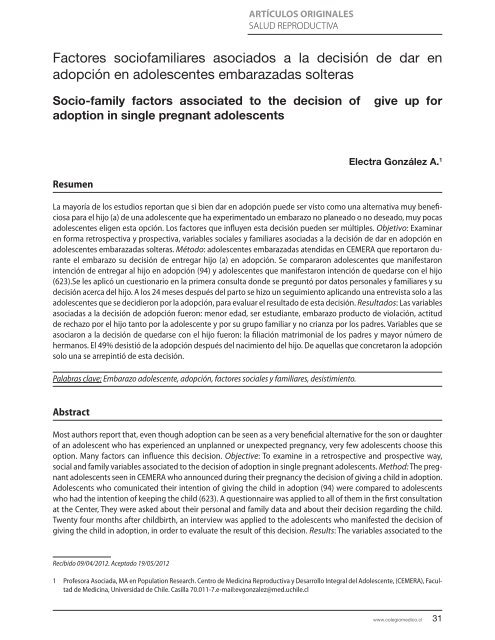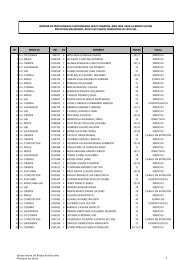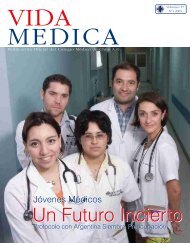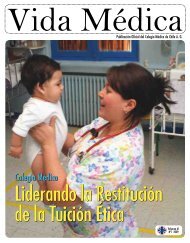CUADERNOS - Colegio Médico de Chile
CUADERNOS - Colegio Médico de Chile
CUADERNOS - Colegio Médico de Chile
Create successful ePaper yourself
Turn your PDF publications into a flip-book with our unique Google optimized e-Paper software.
Factores sociofamiliares asociados a la <strong>de</strong>cisión <strong>de</strong> dar en<br />
adopción en adolescentes embarazadas solteras<br />
Socio-family factors associated to the <strong>de</strong>cision of give up for<br />
adoption in single pregnant adolescents<br />
Resumen<br />
Electra González A. 1<br />
La mayoría <strong>de</strong> los estudios reportan que si bien dar en adopción pue<strong>de</strong> ser visto como una alternativa muy beneficiosa<br />
para el hijo (a) <strong>de</strong> una adolescente que ha experimentado un embarazo no planeado o no <strong>de</strong>seado, muy pocas<br />
adolescentes eligen esta opción. Los factores que influyen esta <strong>de</strong>cisión pue<strong>de</strong>n ser múltiples. Objetivo: Examinar<br />
en forma retrospectiva y prospectiva, variables sociales y familiares asociadas a la <strong>de</strong>cisión <strong>de</strong> dar en adopción en<br />
adolescentes embarazadas solteras. Método: adolescentes embarazadas atendidas en CEMERA que reportaron durante<br />
el embarazo su <strong>de</strong>cisión <strong>de</strong> entregar hijo (a) en adopción. Se compararon adolescentes que manifestaron<br />
intención <strong>de</strong> entregar al hijo en adopción (94) y adolescentes que manifestaron intención <strong>de</strong> quedarse con el hijo<br />
(623).Se les aplicó un cuestionario en la primera consulta don<strong>de</strong> se preguntó por datos personales y familiares y su<br />
<strong>de</strong>cisión acerca <strong>de</strong>l hijo. A los 24 meses <strong>de</strong>spués <strong>de</strong>l parto se hizo un seguimiento aplicando una entrevista solo a las<br />
adolescentes que se <strong>de</strong>cidieron por la adopción, para evaluar el resultado <strong>de</strong> esta <strong>de</strong>cisión. Resultados: Las variables<br />
asociadas a la <strong>de</strong>cisión <strong>de</strong> adopción fueron: menor edad, ser estudiante, embarazo producto <strong>de</strong> violación, actitud<br />
<strong>de</strong> rechazo por el hijo tanto por la adolescente y por su grupo familiar y no crianza por los padres. Variables que se<br />
asociaron a la <strong>de</strong>cisión <strong>de</strong> quedarse con el hijo fueron: la filiación matrimonial <strong>de</strong> los padres y mayor número <strong>de</strong><br />
hermanos. El 49% <strong>de</strong>sistió <strong>de</strong> la adopción <strong>de</strong>spués <strong>de</strong>l nacimiento <strong>de</strong>l hijo. De aquellas que concretaron la adopción<br />
solo una se arrepintió <strong>de</strong> esta <strong>de</strong>cisión.<br />
Palabras clave: Embarazo adolescente, adopción, factores sociales y familiares, <strong>de</strong>sistimiento.<br />
Abstract<br />
Most authors report that, even though adoption can be seen as a very beneficial alternative for the son or daughter<br />
of an adolescent who has experienced an unplanned or unexpected pregnancy, very few adolescents choose this<br />
option. Many factors can influence this <strong>de</strong>cision. Objective: To examine in a retrospective and prospective way,<br />
social and family variables associated to the <strong>de</strong>cision of adoption in single pregnant adolescents. Method: The pregnant<br />
adolescents seen in CEMERA who announced during their pregnancy the <strong>de</strong>cision of giving a child in adoption.<br />
Adolescents who comunicated their intention of giving the child in adoption (94) were compared to adolescents<br />
who had the intention of keeping the child (623). A questionnaire was applied to all of them in the first consultation<br />
at the Center, They were asked about their personal and family data and about their <strong>de</strong>cision regarding the child.<br />
Twenty four months after childbirth, an interview was applied to the adolescents who manifested the <strong>de</strong>cision of<br />
giving the child in adoption, in or<strong>de</strong>r to evaluate the result of this <strong>de</strong>cision. Results: The variables associated to the<br />
Recibido 09/04/2012. Aceptado 19/05/2012<br />
ARTÍCULOS ORIGINALES<br />
SAluD REPRODuCTIVA<br />
1 Profesora Asociada, MA en Population Research. Centro <strong>de</strong> Medicina Reproductiva y Desarrollo Integral <strong>de</strong>l Adolescente, (CEMERA), Facultad<br />
<strong>de</strong> Medicina, Universidad <strong>de</strong> <strong>Chile</strong>. Casilla 70.011-7.e-mail:evgonzalez@med.uchile.cl<br />
www.colegiomedico.cl 31







